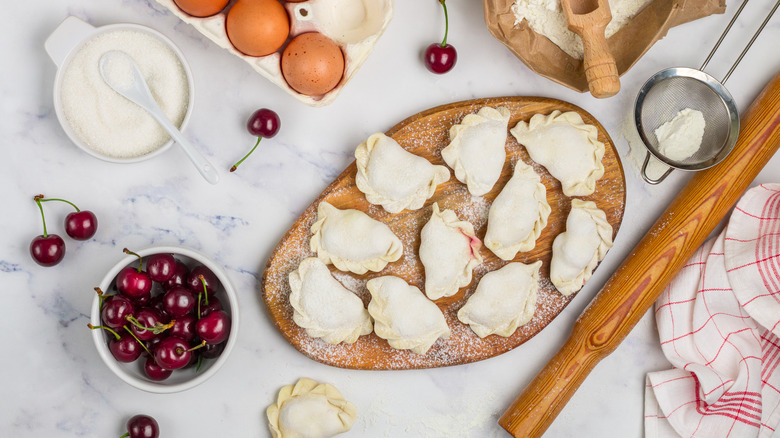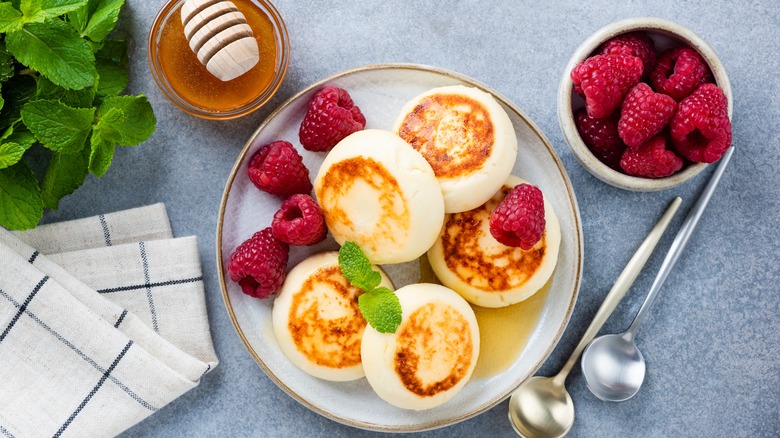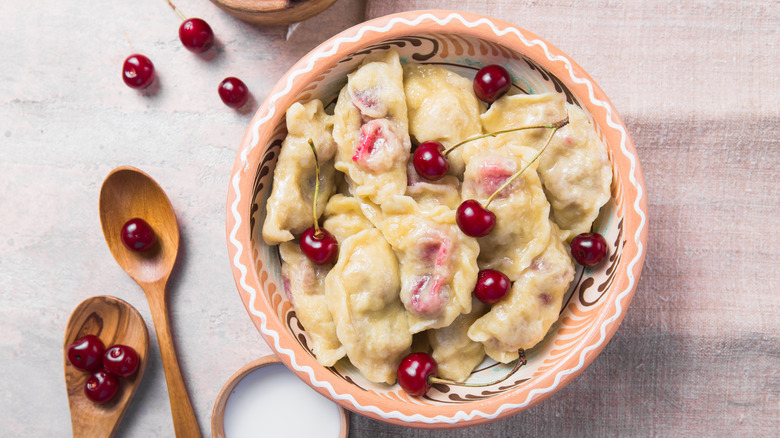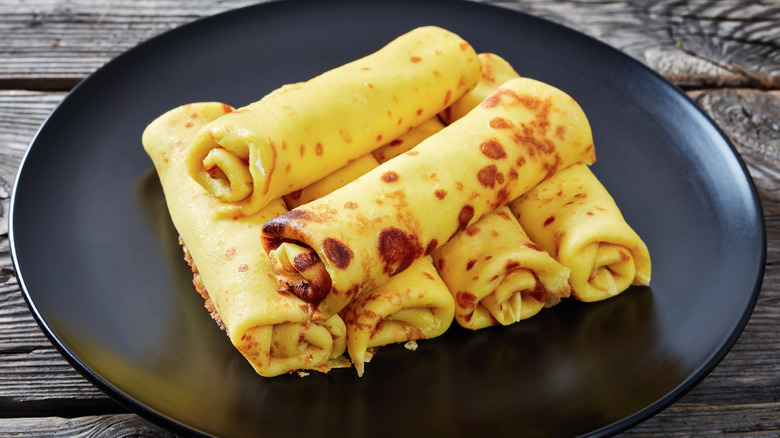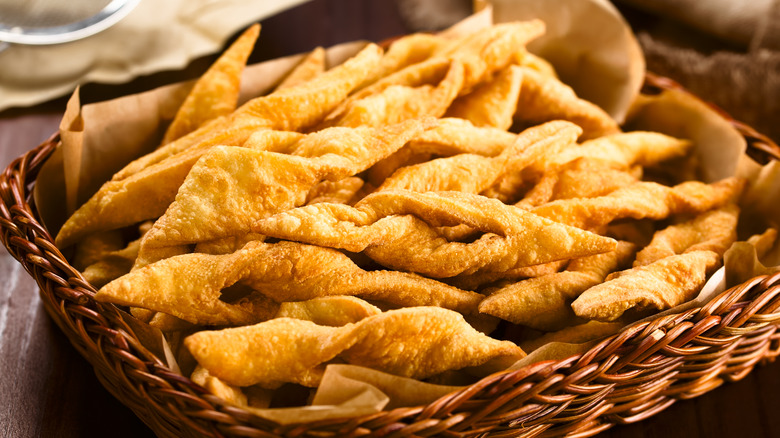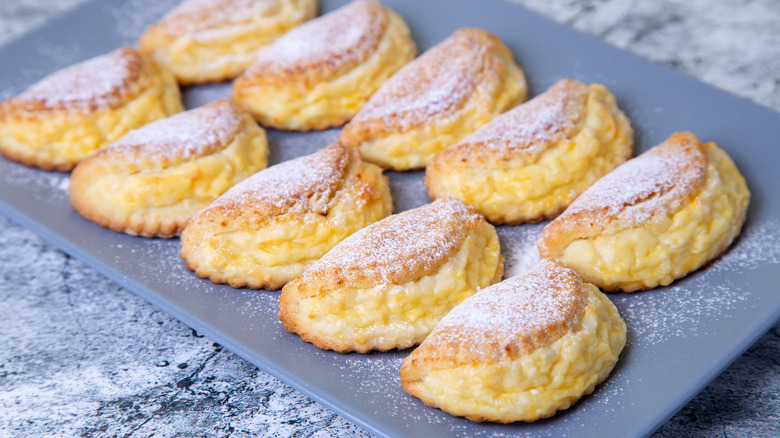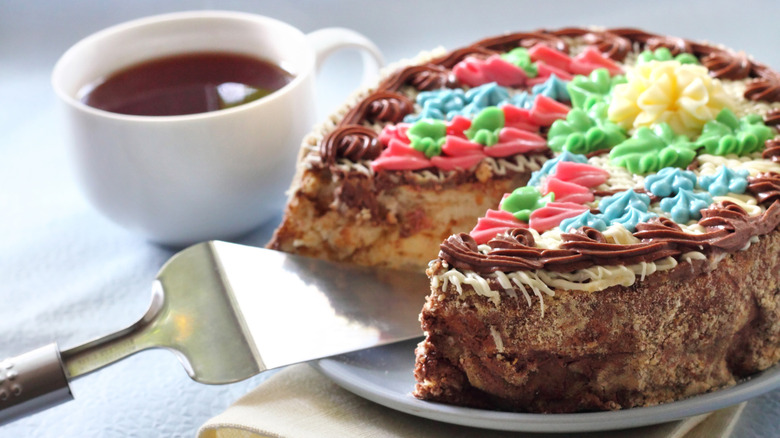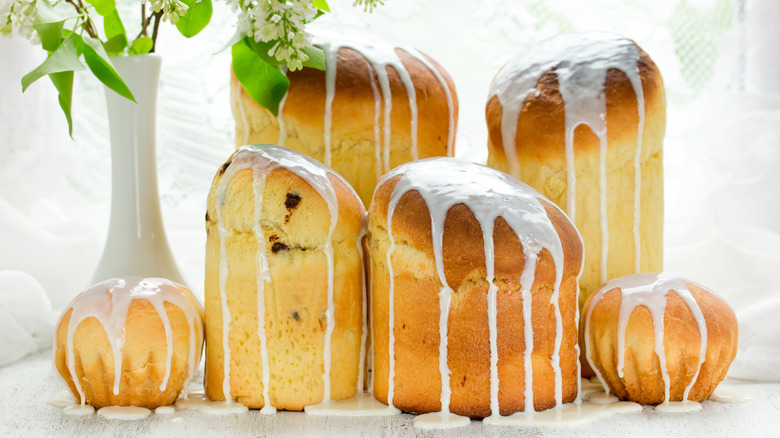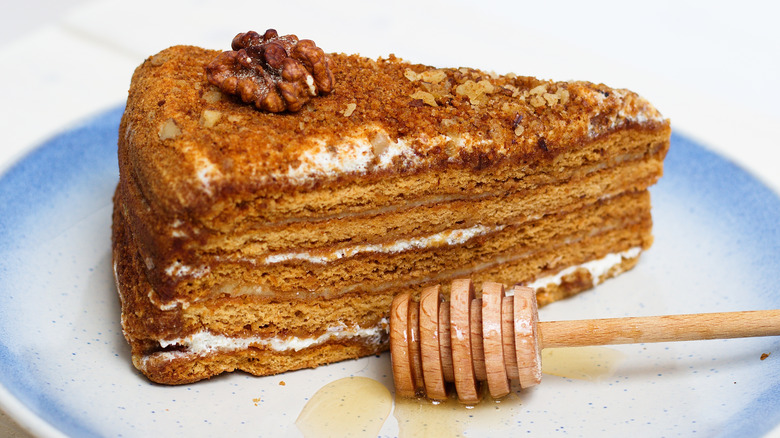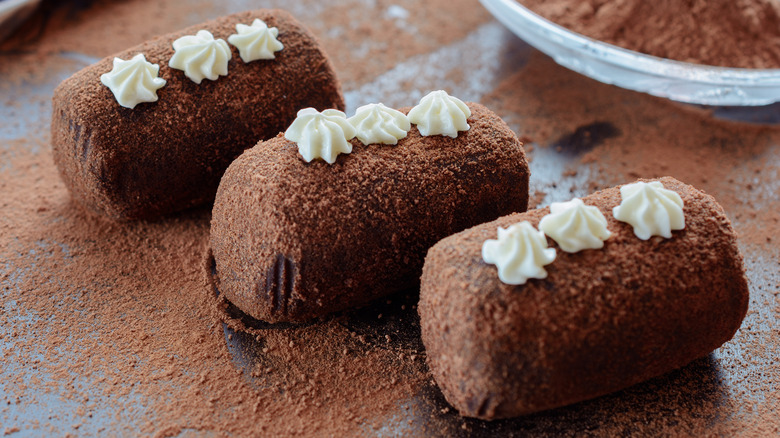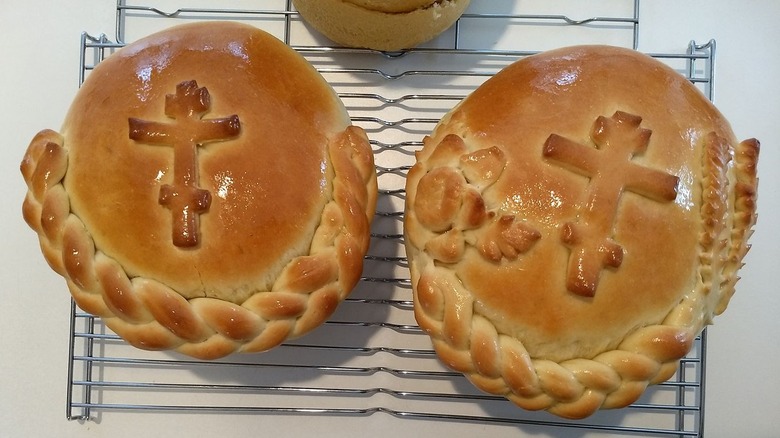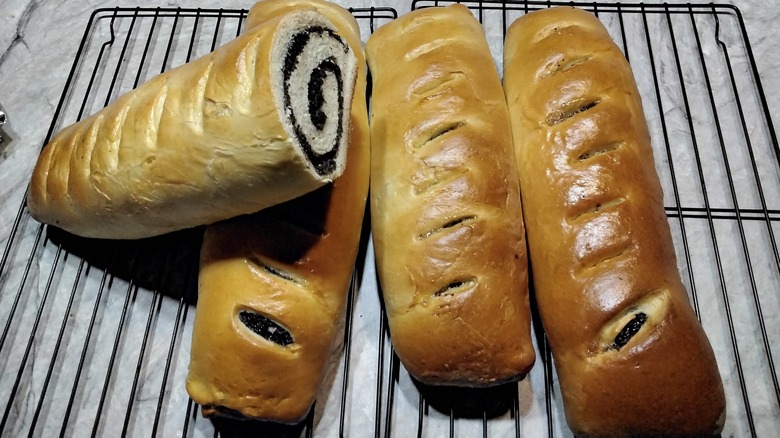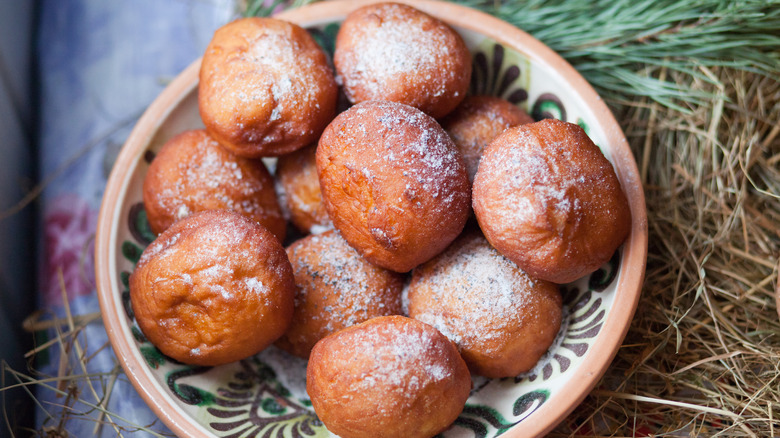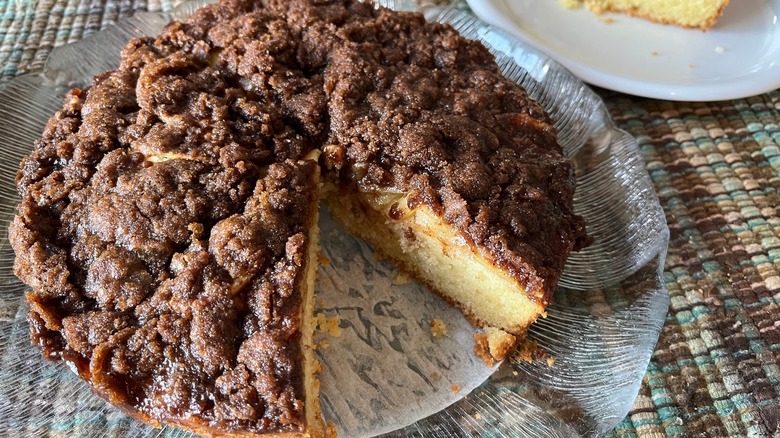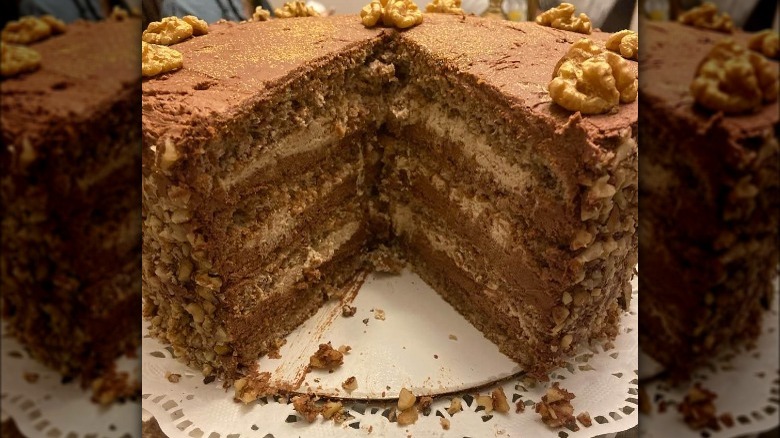16 Ukrainian Desserts Everyone Needs To Try Once
We may receive a commission on purchases made from links.
Sweets treats bring people together, whether it's over a birthday cake, holiday cookies, or a dessert prepared on special occasions. Traditions within specific families and, more broadly, across cultures often dictate what you'll be served. If your sweet tooth is bored of the same old options, it's time you looked beyond the borders of the U.S.
While Ukraine might not be the first place you'd think to look for dessert, the country's diverse history and background have resulted in a wide range of diverse sweets (via Milione). With influences stemming from the Austro-Hungarian Empire as well as the former Soviet Union, many Ukrainian desserts overlap with those from neighboring countries.
From fruit fillings to delights garnished with chocolate, nuts, and honey, there are plenty of ways to satisfy your sweet tooth ... some even include cheese! Read on to discover the Ukrainian desserts you need to try at least once.
1. Syrniki
If you look closely enough, most cultures have a recipe for pancakes served with sweet or savory ingredients. In Ukraine, syrniki is a fried treat made with tvorog, a soft white cheese similar to cottage cheese or quark. According to Folkways, the pancake's round golden appearance is thought to evoke the Slavic god Yarila, who represents fertility, springtime, and the sun. Consequently, they're commonly found at Easter celebrations (via Savella Stechishin in "Traditional Ukrainian Cookery").
Apart from cheese, the batter generally consists of common baking ingredients like eggs, flour, sour cream, butter, and sugar to make a smooth consistency. It can also contain add-ins such as raisins or lemon zest to infuse flavor and subtle texture to the spongy treats (via ifood.tv).
To satisfy sweet cravings, toppings like jam, honey, condensed milk, and fresh fruit or jam complete the dish. While you might find syrniki at the breakfast table, it's just as commonly enjoyed as dessert at the end of a meal. Since you can customize the final garnishes, it's an easy recipe to whip up for a group. You'll be hard-pressed to find someone who can resist the crispy exterior and fluffy center of this delicacy.
2. Varenyki
If you've experimented with various eastern European dumplings, you've probably come across varenyki. The half-moon-shaped treats come with assorted fillings, both savory and sweet. They are well-represented in local literature and culture and are even celebrated with monuments (via Ukrainian People).
The foundation is straightforward, with flour (wheat or buckwheat), egg, curdled (or fermented) milk or water, and salt, as the basic ingredients. The dough is rolled out thinly and stuffed before being dropped into boiling water. For a creamy touch, cottage cheese makes an excellent filling, and a hint of sugar and butter keeps it in dessert territory.
Another popular version incorporates sour cherries, mixed berries, or currants, served with sour cream or honey for a sweet and tart treat. Yet a different variation is made with a poppy seed filling and enjoyed with a drizzle of honey, as described in the book "Proceedings of the Ethnographic and Statistical Expedition to the Western Russian Land" (via Moscow Times).
3. Nalystnyky
When the craving for crepes strikes, nalystnyky is the ideal treat. Thin and buttery, they are rolled up into narrow tubes and filled with sweet or salty ingredients. The batter is quite similar to the French classic and consists of eggs, milk, flour, and butter (via The Rusnaks). A curd cheese filling with sugar and add-ins like vanilla and cinnamon give it a sweet twist. To make it truly authentic, a final frying step is in order. Once the nalystnyky are stuffed and rolled up, they're baked one more time with extra butter for a crispy finish, according to Arousing Appetites.
The outlet points out that the dessert is made with basic staples, which are off-limits during Lent, an important time in the Orthodox tradition. Nalynsky is enjoyed with family and community members to celebrate before this period. To finish off the festivities, any remaining crepes are tossed into a fire for abundance in the upcoming harvests. The crepes often appear at other important celebrations, such as during Christmas.
4. Verhuny
Also referred to as angel wings, the origin of verhuny derives from the verb for dipping in hot fat. Meanwhile, the dessert is referred to as khrusty in Western Ukraine due to its crunchy texture, as Savella Stechishin explains in "Traditional Ukrainian Cookery." Per Authentic Ukraine, the batter is unleavened and made with flour, eggs, sugar, butter, and sour cream, twisted into bow-like strips and then fried in lard. The result is crispy, light, and airy, another nod to their celestial name. While the basic version consists of a simple fried dough served with a sprinkling of powdered sugar, other variations are flavored with lemon zest, rum, vodka, brandy, and almonds.
The crunchy treats are popular during festive holidays, and it's not hard to imagine a chain of people mixing, shaping, and frying the dough before enjoying them together. The cookies garner plenty of admiration from fans and are even the subject of a museum in the town of Chechelevo, where you can learn all about the dessert's history. Per a blog post on Brown University's Tiny Exhibits website, verhuny are recreated in many surrounding countries, such as Lithuania.
5. Sochniki
Stuffed pastries make for an extra special treat since there's an element of surprise that keeps diners eager to unearth the goodness inside. Sochniki receives plenty of love from Ukrainians with a sweet tooth, and once you taste the flaky pastry, you'll be on board. As many recipes from Ukraine date back to the Soviet Union, sochniki is popular in Russia too. According to Russia Beyond, the dessert was incredibly common in school canteens since it was both inexpensive and easy to make.
A basic version consists of shortcrust pastry with a lightly sweetened sour cream and cheese filling flavored with a hint of vanilla. Per Discover Ukraine, the cheese component can even be mixed into the dough for a unique texture, which some fans compare to a cross between a scone and a cheesecake (via Reddit). As well the filling can include other ingredients, such as berries and assorted fruit.
6. Kyiv cake
Revered dishes are often the source of much story-telling, and that's certainly the case with Kyiv cake. Named after the country's capital city, a couple of tales are cited as being the source of its invention. One of them dates back to 1956 when a confectionary factory pastry worker forgot to refrigerate egg whites for a cake and had to quickly reinvent the dessert he was making when they fermented (via Destinations). The result was a layered meringue cake with nuts (walnuts, cashews, and hazelnuts show up in various versions) coated with buttercream (via 196 Flavors).
Another account claims that the cake was actually intentionally made by a budding young pastry chef. The recipe was carefully labored upon and has not been changed since. Either way, it soon won awards (and hearts) and received a patent in 1973. For many years, visitors to Kyiv knew to pick up the iconic dessert as a souvenir, even going so far as to stand in line at 4 a.m. to guarantee a cake (via Authentic Ukraine). The real deal is only made at the original Roshen confectionary, though home-baked versions (if you have the patience) are just as delicious.
7. Babka
Babkas are well-represented in various eastern European countries and in the Jewish tradition, and it's easy to see why. The subtly sweet, fragrant, and airy bread can easily be customized or kept simple. Whereas some versions are merely sweet and leavened rich eggy bread, others are aromatized with assorted ingredients like citrus zest, saffron, and raisins (via Northcentral PA).
Most notably, babka is a key dessert bread in Easter traditions and is often included in a festive basket to celebrate the occasion since bread is considered sacred (via The Winnipeg Free Press). Babkas are commonly glazed or brushed with a simple egg wash. Historically, the cylinder-shaped loaf represents the woman or the mother figure, while other depictions connect it to fertility (via The Atlantic). Accordingly, the name is closely associated with baba, or grandmother, with babka being a diminutive form of the word. There's nothing diminutive about this treat, though; it will make a sweet bread lover out of anyone.
8. Medivnyk
Savella Stechishin highlights the popularity of baking with honey in "Traditional Ukrainian Cookery" and explains that beekeeping has long been a prevalent practice in the country. This led to the creation of plenty of honey-laden dessert recipes, particularly before sugar became more common. Many of these treats grace the Christmas dinner table, most notably medivnyk, which translates to honey cake in honor of its star ingredient.
If you're preparing a honey cake, Stechishin explains that letting it sit for a few days "to ripen" is an important part of the process. It is usually made with eight layers, adding to the laborious method, but definitely worth it when you bite into the moist cake (via The Travel). Along with honey, the cake calls for assorted spices (cinnamon, nutmeg, and cloves), dried fruit like dates, raisins, currants, and walnuts, as well as brewed coffee. The remaining ingredients are baking staples like flour, butter, sugar, eggs, and leavening agents.
Meanwhile, some recipes opt for fewer add-ins and incorporate sour cream for a lighter cake. In fact, this is the recipe behind the popular story of the cake's origin. 19th-century Empress Elizabeth Alexeievna disdained the taste of honey until she tried the cake, which balanced the floral aromas with sour cream. Whatever the origin, this cake is still firmly rooted in Ukrainian celebrations.
9. Kartoshka
Although this dessert's name stems from the word for potato, thankfully, no starchy spuds are present in kartoshkas (via Atlas Obscura). That being said, appearance-wise, they veer into root vegetable territory unless sporting frosting or nuts as garnish. This treat came about as a thrifty way to make use of cookies and cake crumbs.
While you might not think twice about tossing out a plate of crumbs, in settings like canteens and other large dining spaces, they add up fast. Considering the frequent food shortages and rationing in the Soviet Union, it was wise to use what would be wastefully thrown out. Even beyond these frugal times, kartoshka continues to be a popular dessert.
The crumbs are turned into a mass by combining them with various ingredients such as butter, milk, sugar, or sweetened condensed milk (via Odessa Journal). The exterior is dusted with cacao powder, and the occasional addition of spirits, candied fruits, or nuts completes the treat. Formed into logs or balls, kartoshkas are chilled before serving.
10. Paska
Along with a hearty loaf of babka in Easter baskets, Ukrainian families commonly enjoy paska too. While the two types of bread often go hand in hand, paska generally has a rounder and flatter shape (via Sova Books). The sweet bread is fairly straightforward and made from flour, yeast, milk, butter, sugar, and eggs, with occasional add-ins to flavor the dough. A slice of paska is ideal for a subtly sweet treat, but it is also enjoyed slathered with jam, cream cheese, and butter or drizzled with honey for extra flavor (via The Kingston Whig Standard).
While one bread would probably suffice for a family, Ukrainian ethnographer Stephan Kylymnyk writes in the book, "The Calendar Year in Ukrainian Folklore" that some customs call for three loaves — yellow, white, and black — to represent the sun and sky, the wind and the dead, and the land and the living. Traditionally, dough designs are baked onto the loaf to decorate the exterior with imagery to portray spring or various figures of Christianity. Even more symbolic, paska is often served as the first food at Easter to highlight the end of Lent and is involved in various aspects of the religious ceremony.
11. Makivnyk
Poppy seeds are showcased in a number of Ukrainian desserts, including makivnyk, a sweet roll. Ukrainian pastry chef Myroslava Mykytyn explains that the treat comes to life by layering an eggy brioche dough with a poppy seed paste filling (via Edible Ottawa). The result can be log-like or coiled with visible poppy seeds throughout. Some variations include other ingredients like walnuts, raisins, or honey, but the basic poppy seed version is classic.
For successful results, the poppy seeds need first to be soaked and ground until the color lightens and the texture becomes smooth and not so grainy. Traditionally the seeds were ground by hand, but modern bakers like Mykytyn use appliances like a Vitamix to simplify the steps. Once the dough and paste are layered and rolled, the pastry is baked in the oven (via Discover Ukraine). It can be glazed or sprinkled with powdered sugar as a finishing touch, but the notable flavor of poppy seeds always comes out on top.
12. Pampushky
Among the typical holiday desserts, pampushky are an all-time favorite served at Christmas Eve dinner according to Savella Stechishin (via "Traditional Ukrainian Cookery"). The author explains that the name means puffs, a clear reference to the pastry's airy appearance. A basic pampushky recipe calls for a sweet yeast-leavened dough shaped into a bun and fried in hot lard, making the dessert the Ukrainian equivalent of a donut.
The buns can be plain or filled with assorted ingredients like poppy seeds, jam, or sweetened prune paste. According to the book "Sweet Treats Around the World", the filling can consist of other flavorings like rose petal preserves. While you can eat hot pampushky fresh from the fryer, a sprinkling of sugar and cinnamon adds a delicate hint of sweetness and spice to complete these delightful treats. If you find yourself ordering the fried buns from a menu, be careful to note whether it is the savory version seasoned with garlic and often served with borscht (via Ukrainian Recipes).
13. Yabluchnyk
Fruit is at the heart of a number of Ukrainian desserts, and Savella Stechishin highlights its role in her book "Traditional Ukrainian Cookery." She explains that it is regularly served by itself at the end of ordinary meals or presented with cream, stewed, or mixed into intricate recipes on special occasions. While pies, as we know them in the U.S., are not so common in Ukraine, fruit pastries made with short or puff pastry or cookie dough are more prevalent.
One popular dessert that showcases fruit is yabluchnyk, an apple cake. The batter is simply made with baking staples like flour, sugar, leavening agents, butter, eggs, and cream to make up the spongy base of the cake. Sliced apples with cinnamon, sugar, and butter are scattered over the dough to make a thick fruit topping. If apples are unavailable, other fruits like black cherries, peaches, pears, or plums are commonly used.
14. Walnut Torte
Nuts may be a luxury in some areas of the world, but traditionally they are a mainstay ingredient of Ukrainian baking. Savella Stechishin explains that hazelnuts are found all over the country, but almonds and walnuts are mainly concentrated in the province of Bessarabia in the south (via "Traditional Ukrainian Cookery"). Nuts are often ground into a paste or flour and used as fillings, toppings, or the bulk of a pastry.
Walnut tortes are a fine example of the hearty nut at its prime, distinguished by the heavy use of eggs and minimal (if any) flour content. The celebratory cake has many variations, such as with layers of walnut cake, mocha frosting, and coffee cream or a walnut base, with buttercream, liqueur, and chocolate components (via Cruise Connections). Marta Pisetska Farley's "Festive Ukrainian Cooking" details a recipe with a ground walnut layer and mocha sherry custard decorated with chocolate icing and warns home bakers to set aside ample time to prepare the multilayered treat.
